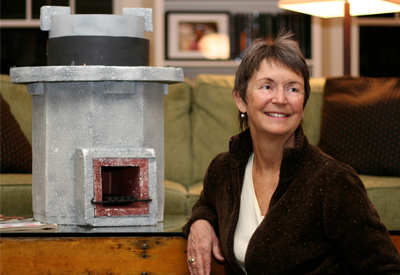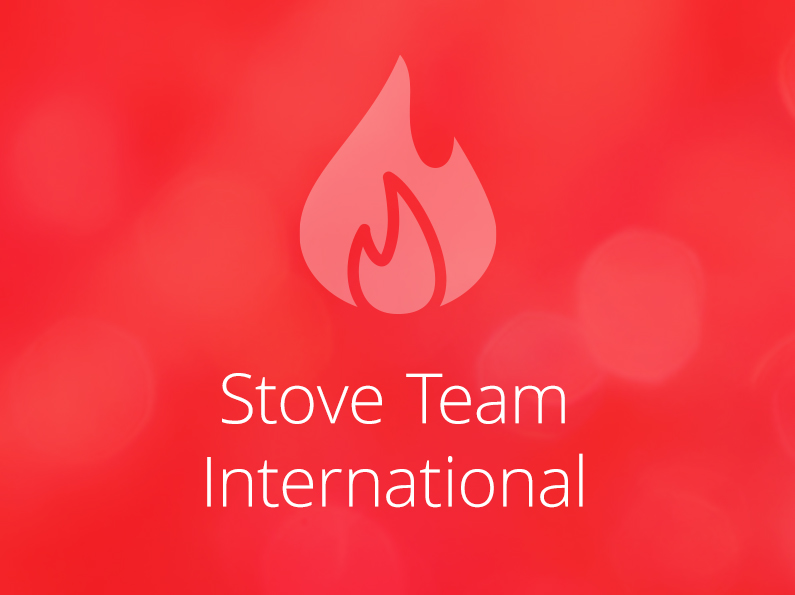 A fixture of most houses in the world is an open fire or inefficient wood stove inside the house. The fire is smoky and is the most serious health hazard in the world for children under five; the children die of respiratory disease or are severely burned. If you walked into such a house while the stove is burning, you would find it difficult to breathe and your eyes would water due to the smoke. Even if the fire was not burning it would be difficult to breathe because of the odor of black creosote coating the ceiling and wall near the fire. Every few days people must gather or purchase 50 or so pounds of wood; it takes them longer or costs more each year because that much wood usage causes severe deforestation.
A fixture of most houses in the world is an open fire or inefficient wood stove inside the house. The fire is smoky and is the most serious health hazard in the world for children under five; the children die of respiratory disease or are severely burned. If you walked into such a house while the stove is burning, you would find it difficult to breathe and your eyes would water due to the smoke. Even if the fire was not burning it would be difficult to breathe because of the odor of black creosote coating the ceiling and wall near the fire. Every few days people must gather or purchase 50 or so pounds of wood; it takes them longer or costs more each year because that much wood usage causes severe deforestation.
Medical and ecological problems due to the use of such cooking methods include:
- Chronic bronchial illnesses, especially for women and children who spend most of their time in smoke-filled homes. Smoke from indoor cooking fires is the leading cause of death of children under age five. It kills eight times as many children as malaria;
- Debilitating scars resulting when children who fall in the open fires do not receive medical treatment;
- Increased incidence of eye problems such as pterygium, a condition often exacerbated by constant exposure to smoke;
- Exposure to creosote, the result of incomplete combustion in the open fires, which coats the insides of homes and hangs in long strings from interior roof supports;
- High incidence of hernias and back and neck problems among the women and children who carry up to 100 pounds of fuel wood a day on their backs and heads;
- Exposure to creosote, the result of incomplete combustion in the open fires, which coats the insides of homes and hangs in long strings from interior roof supports;
- High incidence of hernias and back and neck problems among the women and children who carry up to 100 pounds of fuel wood a day on their backs and heads;
- Increasing deforestation as villagers seek fuel wood deeper in forested areas;
- Continuing threats of mudslides and floods as steep mountain slopes are deforested.
 Open indoor fires contribute very substantially to outdoor pollution as well as indoor pollution. The vice-minister of the environment in El Salvador told us that indoor fires have been estimated to contribute 30% of outdoor pollution in the country.
Open indoor fires contribute very substantially to outdoor pollution as well as indoor pollution. The vice-minister of the environment in El Salvador told us that indoor fires have been estimated to contribute 30% of outdoor pollution in the country.
When we ask people what the most important benefits of their new stoves are, most often they will talk about how much less wood they have to collect, reducing the aches and pains of carrying that much wood for great distances, and giving them much more time for other activities each day. Others will talk about how they can now breathe more easily and how much better they and their children feel.
Last year at a public meeting in El Salvador, a school counselor introduced a young girl she had brought to the meeting. This girl had been unable to attend school for years because of respiratory difficulties and lack of strength. Then the girl got up in front of many people and articulately told her own story with an enormous smile and confidence in the future.
 StoveTeam has helped local entrepreneurs establish factories in five countries in Latin America. These locally owned, self-sustaining businesses produce safe, affordable, fuel-efficient cookstoves to replace dangerous open new skills and it is ultimately the local people who who solve their own problems in their own ways. Ecocina factories have produced more than 37,000 stoves, improving the lives of more than 280,000 people. StoveTeam’s model has been awarded the U.S. Environmental Protection Agency Partnership for Clean Indoor Air Award for Developing Local Markets for our innovative approach creating local employment while improving health and reducing air pollution.
StoveTeam has helped local entrepreneurs establish factories in five countries in Latin America. These locally owned, self-sustaining businesses produce safe, affordable, fuel-efficient cookstoves to replace dangerous open new skills and it is ultimately the local people who who solve their own problems in their own ways. Ecocina factories have produced more than 37,000 stoves, improving the lives of more than 280,000 people. StoveTeam’s model has been awarded the U.S. Environmental Protection Agency Partnership for Clean Indoor Air Award for Developing Local Markets for our innovative approach creating local employment while improving health and reducing air pollution.
Contact Nancy Hughes or Gerry Reicher for more information on how to get involved.

